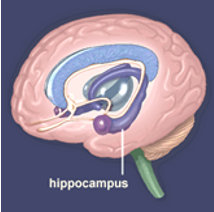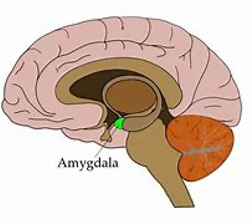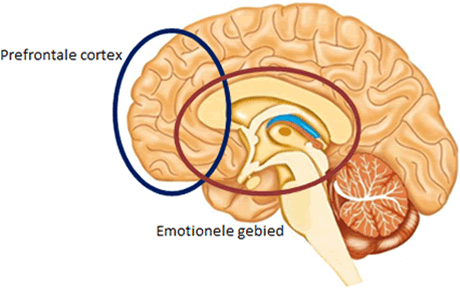Two hemispheres
The two halves (hemispheres) of your brain have separate but complementary functions.
- The right hemisphere includes images, holistic thinking, non-verbal communication, autobiographical memory.
- The left hemisphere is responsible for logic, language, linearity and literal thinking.
In the case of narrative integration, these two ways of experiencing and giving attention are integrated with each other. This allows you to give your life meaning in a deeper way.
Triggers and implicit memory
Regressive behaviour is often triggered by a sensory stimulus that is neutral in itself, such as an image, a word, a sound or a smell. The emotional and behavioural response to this stimulus is of an intensity that you would not expect. If that is the case, we call such a stimulus a “trigger”. Triggers work unconsciously. In regression therapy, we investigate, together with our client, why this trigger is so loaded. Psychological research over the past decades has provided us with a great deal of new knowledge about how our memory works. An important concept in this context is implicit memory. The researchers speak of “implicit” because these memories are tacitly present. That is, you are not aware of it. You don’t know they are saved. No focus of attention is required to store these kinds of memories. This explains the often explosive and unexpected effect of triggers. In our approach to therapy we consider these implicit memory contents to be forms of involuntary trance, also known as natural trance.
Implicit memory and the brain
 Implicit contents are stored in areas of the brain that generate emotions, such as the amygdala. This organ deep in our brain, in the so-called limbic system, is considered the centre of our emotional memory.
Implicit contents are stored in areas of the brain that generate emotions, such as the amygdala. This organ deep in our brain, in the so-called limbic system, is considered the centre of our emotional memory.
Because these memories are stored deep in the brain, you can regard implicit memory as non-verbal memory. Your implicit memory has been there from birth. Implicit memories contain the following elements: behavioural impulses, affective experiences and sensory impressions.
Explicit memory and the brain
In addition to implicit memory, there is the explicit, where you can remember events as facts and as subjective experience. Explicit memories are only possible after your brain has gone through a certain growth. In the first year and a half of your life, your brain undergoes rapid growth. During this time, organs such as the hippocampus and the prefrontal cortex develop. These allow for explicit memories. But before that, your brain has already stored many implicit memories.
Memories stored in the explicit memory are clearly present. You can let these memories (images, facts, feelings, body sensations, etc.) appear in your consciousness. This is therefore a thought or image from the past that you can consciously recall in your memory. In the case of explicit memory we make a distinction between so-called autobiographical
 and semantic memory. Autobiographical memory includes personal events. Semantic memory contains “meanings” and “facts”, for example your vocabulary, being able to tell how to bake an egg, what the queen is called, tell the time, add two numbers, knowledge of the world, knowledge of the language.
and semantic memory. Autobiographical memory includes personal events. Semantic memory contains “meanings” and “facts”, for example your vocabulary, being able to tell how to bake an egg, what the queen is called, tell the time, add two numbers, knowledge of the world, knowledge of the language.
A memory only becomes explicit when you can remember an event as a fact. In addition, it is important that you also experience the event as a subjective personal experience. Unlike an implicit memory, an explicit one has a sense of self and time.
Vertical integration

Neurologically oriented therapists (such as Daniel Siegel) often speak of vertical integration as a result of a therapy process, that is, integration of the higher cortical parts of our brain (where our explicit memories reside) with the deeper layers (where implicit memories are stored). Vertical integration promotes proper regulation of your emotions. Vertical integration brings your senses and body feelings to awareness and enhances your intuitive abilities.

